tow MERCEDES-BENZ C300 4MATIC 2010 W204 Owner's Manual
[x] Cancel search | Manufacturer: MERCEDES-BENZ, Model Year: 2010, Model line: C300 4MATIC, Model: MERCEDES-BENZ C300 4MATIC 2010 W204Pages: 364, PDF Size: 8.23 MB
Page 10 of 364
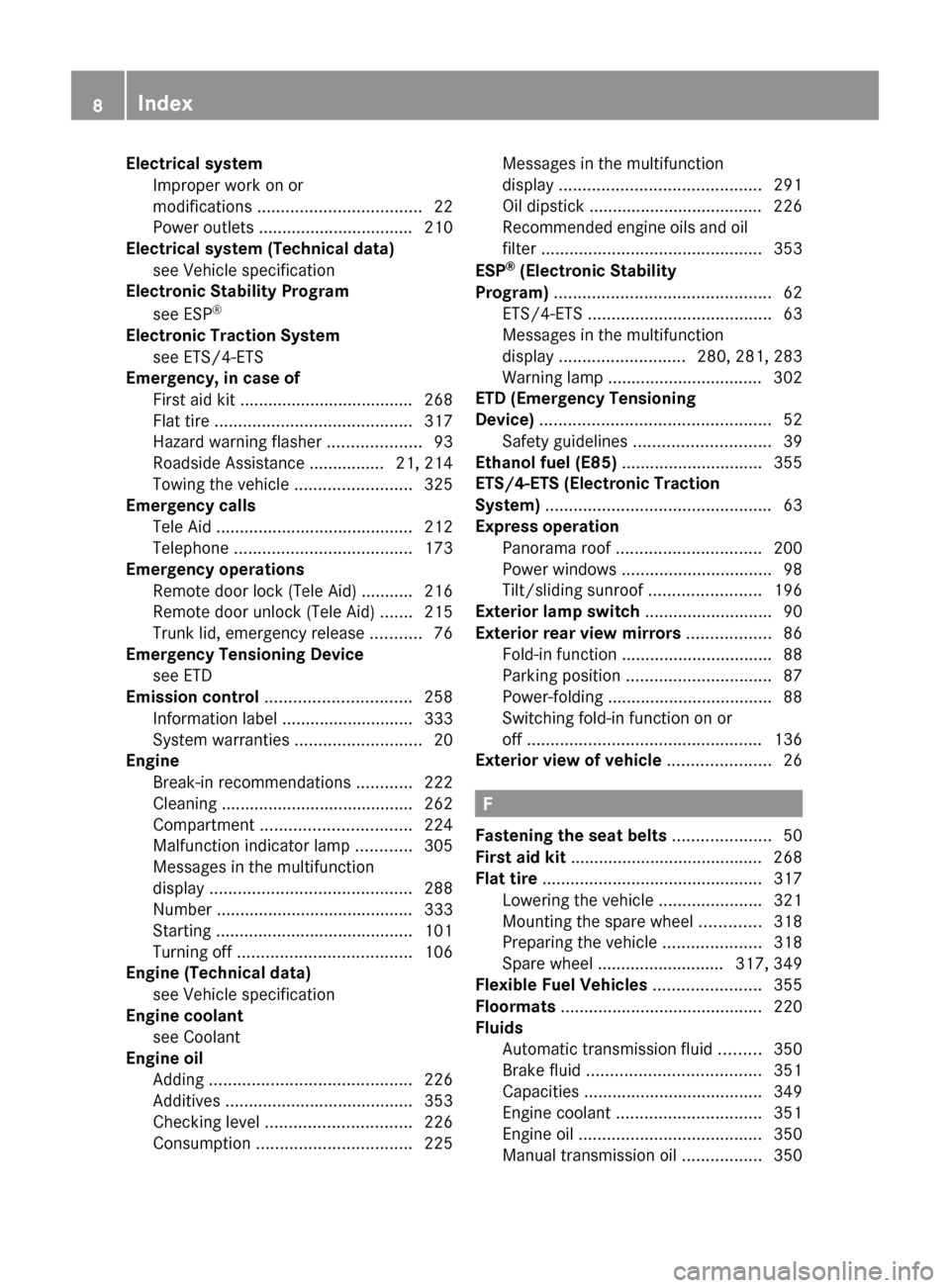
Electrical system
Improper work on or
modifications ................................... 22
Power outlets ................................. 210
Electrical system (Technical data)
see Vehicle specification
Electronic Stability Program
see ESP ®
Electronic Traction System
see ETS/4-ETS
Emergency, in case of
First aid kit ..................................... 268
Flat tire .......................................... 317
Hazard warning flasher ....................93
Roadside Assistance ................ 21, 214
Towing the vehicle .........................325
Emergency calls
Tele Aid .......................................... 212
Telephone ...................................... 173
Emergency operations
Remote door lock (Tele Aid) ........... 216
Remote door unlock (Tele Aid) .......215
Trunk lid, emergency release ...........76
Emergency Tensioning Device
see ETD
Emission control ............................... 258
Information label ............................ 333
System warranties ...........................20
Engine
Break-in recommendations ............222
Cleaning ......................................... 262
Compartment ................................ 224
Malfunction indicator lamp ............305
Messages in the multifunction
display ........................................... 288
Number .......................................... 333
Starting .......................................... 101
Turning off ..................................... 106
Engine (Technical data)
see Vehicle specification
Engine coolant
see Coolant
Engine oil
Adding ........................................... 226
Additives ........................................ 353
Checking level ............................... 226
Consumption ................................. 225Messages in the multifunction
display ........................................... 291
Oil dipstick ..................................... 226
Recommended engine oils and oil
filter ............................................... 353
ESP ®
(Electronic Stability
Program) .............................................. 62
ETS/4-ETS ....................................... 63
Messages in the multifunction
display ........................... 280, 281, 283
Warning lamp ................................. 302
ETD (Emergency Tensioning
Device) ................................................. 52
Safety guidelines ............................. 39
Ethanol fuel (E85) .............................. 355
ETS/4-ETS (Electronic Traction
System) ................................................ 63
Express operation
Panorama roof ............................... 200
Power windows ................................ 98
Tilt/sliding sunroof ........................196
Exterior lamp switch ........................... 90
Exterior rear view mirrors .................. 86
Fold-in function ................................ 88
Parking position ............................... 87
Power-folding ................................... 88
Switching fold-in function on or
off .................................................. 136
Exterior view of vehicle ...................... 26
F
Fastening the seat belts ..................... 50
First aid kit ......................................... 268
Flat tire ............................................... 317
Lowering the vehicle ......................321
Mounting the spare wheel .............318
Preparing the vehicle .....................318
Spare wheel ........................... 317, 349
Flexible Fuel Vehicles ....................... 355
Floormats ........................................... 220
Fluids
Automatic transmission fluid .........350
Brake fluid ..................................... 351
Capacities ...................................... 349
Engine coolant ............................... 351
Engine oil ....................................... 350
Manual transmission oil .................350
8Index204_AKB; 5; 23, en-USd2ureepe,Version: 2.11.8.12009-07-16T17:54:06+02:00 - Seite 8
Page 19 of 364
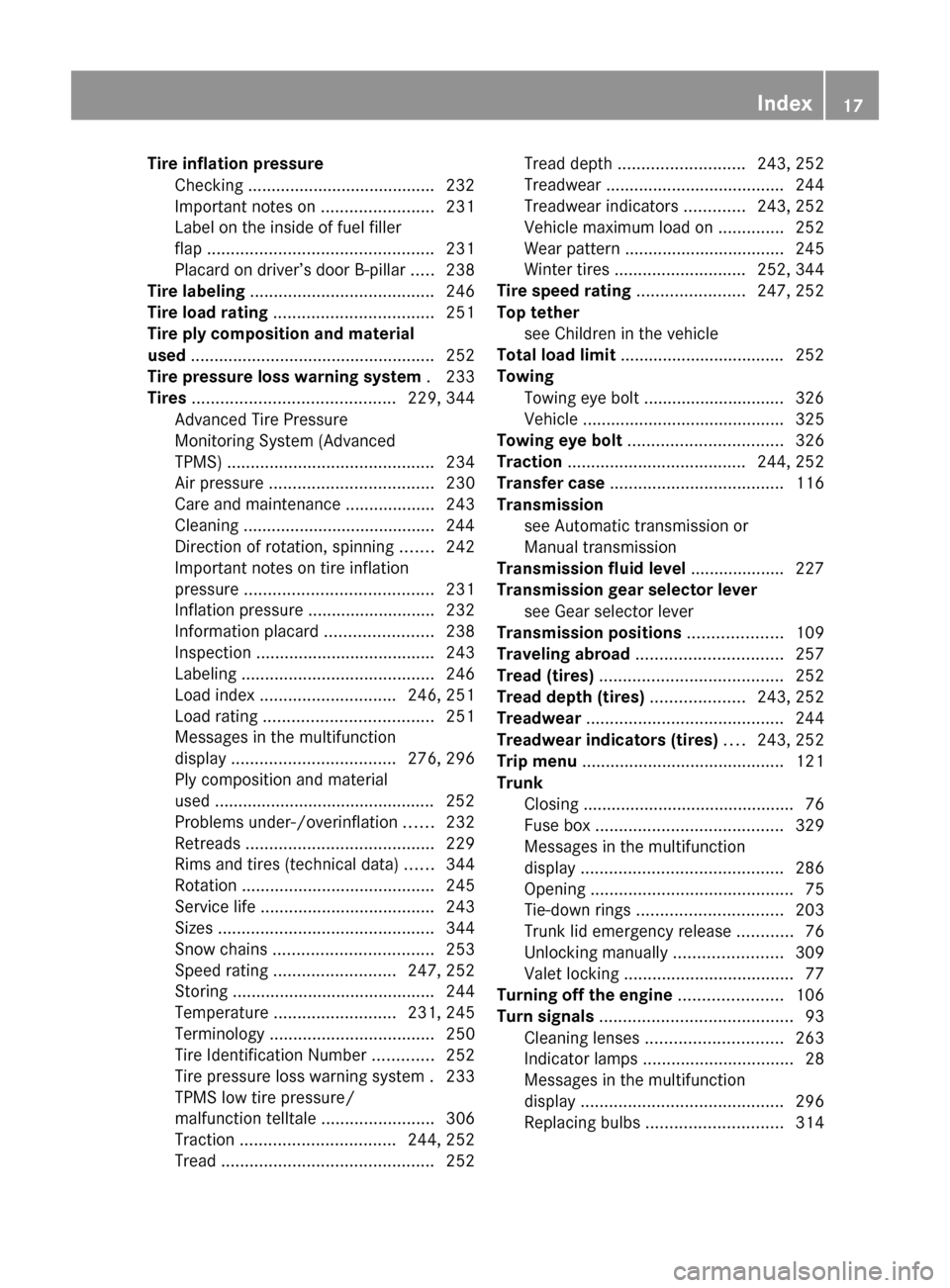
Tire inflation pressure
Checking ........................................ 232
Important notes on ........................231
Label on the inside of fuel filler
flap ................................................ 231
Placard on driver’s door B-pillar .....238
Tire labeling ....................................... 246
Tire load rating .................................. 251
Tire ply composition and material
used .................................................... 252
Tire pressure loss warning system . 233
Tires ........................................... 229, 344
Advanced Tire Pressure
Monitoring System (Advanced
TPMS) ............................................ 234
Air pressure ................................... 230
Care and maintenance ...................243
Cleaning ......................................... 244
Direction of rotation, spinning .......242
Important notes on tire inflation
pressure ........................................ 231
Inflation pressure ........................... 232
Information placard .......................238
Inspection ...................................... 243
Labeling ......................................... 246
Load index ............................. 246, 251
Load rating .................................... 251
Messages in the multifunction
display ................................... 276, 296
Ply composition and material
used ............................................... 252
Problems under-/overinflation ......232
Retreads ........................................ 229
Rims and tires (technical data) ......344
Rotation ......................................... 245
Service life ..................................... 243
Sizes .............................................. 344
Snow chains .................................. 253
Speed rating .......................... 247, 252
Storing ........................................... 244
Temperature .......................... 231, 245
Terminology ................................... 250
Tire Identification Number .............252
Tire pressure loss warning system . 233
TPMS low tire pressure/
malfunction telltale ........................306
Traction ................................. 244, 252
Tread ............................................. 252Tread depth ........................... 243, 252
Treadwear ...................................... 244
Treadwear indicators .............243, 252
Vehicle maximum load on ..............252
Wear pattern .................................. 245
Winter tires ............................ 252, 344
Tire speed rating ....................... 247, 252
Top tether see Children in the vehicle
Total load limit ................................... 252
Towing
Towing eye bolt .............................. 326
Vehicle ........................................... 325
Towing eye bolt ................................. 326
Traction ...................................... 244, 252
Transfer case ..................................... 116
Transmission see Automatic transmission or
Manual transmission
Transmission fluid level .................... 227
Transmission gear selector lever see Gear selector lever
Transmission positions .................... 109
Traveling abroad ............................... 257
Tread (tires) ....................................... 252
Tread depth (tires) .................... 243, 252
Treadwear .......................................... 244
Treadwear indicators (tires) .... 243, 252
Trip menu ........................................... 121
Trunk
Closing ............................................. 76
Fuse box ........................................ 329
Messages in the multifunction
display ........................................... 286
Opening ........................................... 75
Tie-down rings ............................... 203
Trunk lid emergency release ............76
Unlocking manually .......................309
Valet locking .................................... 77
Turning off the engine ...................... 106
Turn signals ......................................... 93
Cleaning lenses ............................. 263
Indicator lamps ................................ 28
Messages in the multifunction
display ........................................... 296
Replacing bulbs ............................. 314Index17204_AKB; 5; 23, en-USd2ureepe,Version: 2.11.8.12009-07-16T17:54:06+02:00 - Seite 17
Page 20 of 364
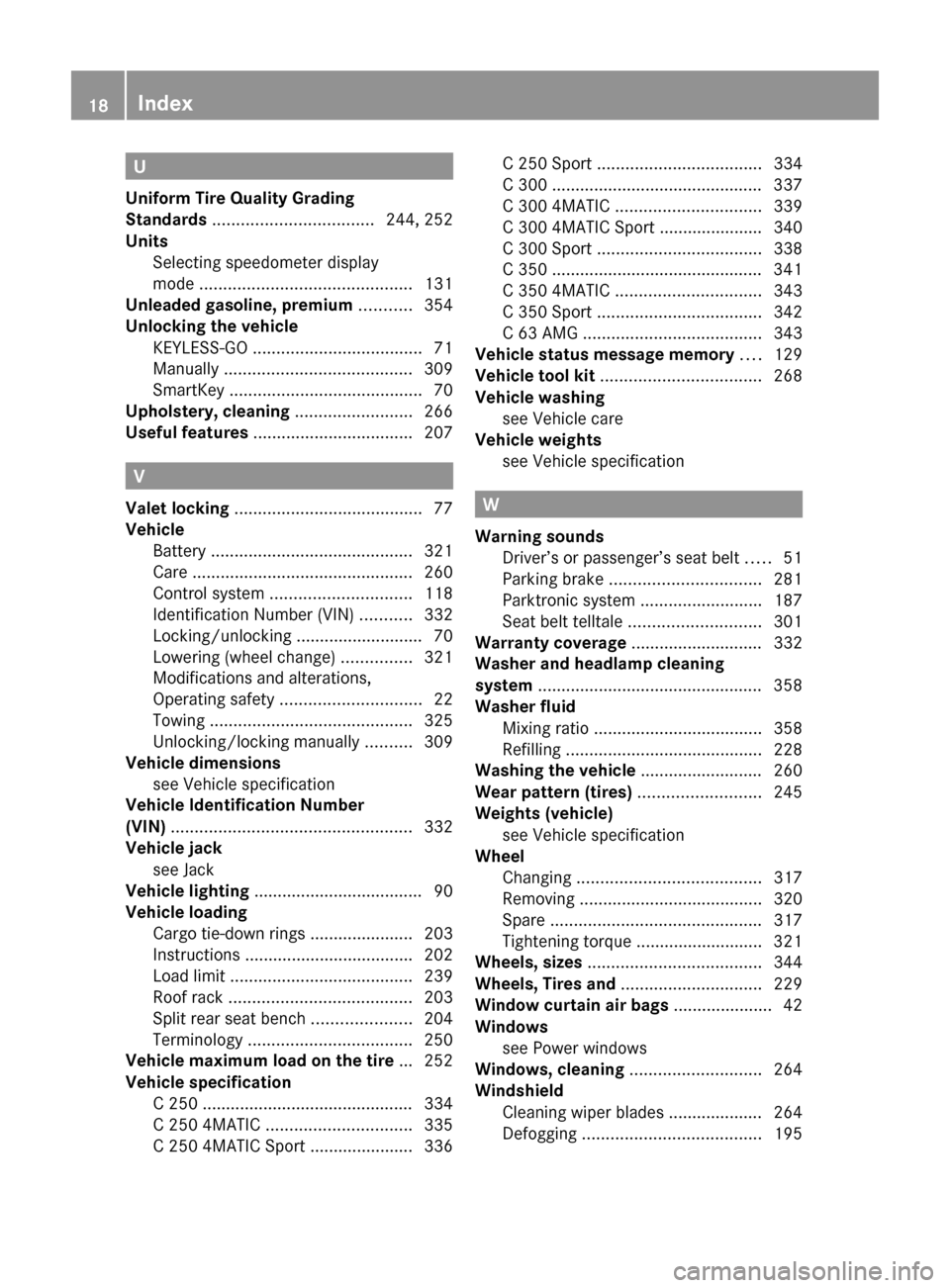
U
Uniform Tire Quality Grading
Standards .................................. 244, 252
Units
Selecting speedometer display
mode ............................................. 131
Unleaded gasoline, premium ........... 354
Unlocking the vehicle
KEYLESS-GO .................................... 71
Manually ........................................ 309
SmartKey ......................................... 70
Upholstery, cleaning ......................... 266
Useful features .................................. 207
V
Valet locking ........................................ 77
Vehicle
Battery ........................................... 321
Care ............................................... 260
Control system .............................. 118
Identification Number (VIN) ...........332
Locking/unlocking ........................... 70
Lowering (wheel change) ...............321
Modifications and alterations,
Operating safety .............................. 22
Towing ........................................... 325
Unlocking/locking manually ..........309
Vehicle dimensions
see Vehicle specification
Vehicle Identification Number
(VIN) ................................................... 332
Vehicle jack see Jack
Vehicle lighting .................................... 90
Vehicle loading
Cargo tie-down rings ...................... 203
Instructions .................................... 202
Load limit ....................................... 239
Roof rack ....................................... 203
Split rear seat bench .....................204
Terminology ................................... 250
Vehicle maximum load on the tire ... 252
Vehicle specification
C 250 ............................................. 334
C 250 4MATIC ............................... 335
C 250 4MATIC Sport ...................... 336
C 250 Sport ................................... 334
C 300 ............................................. 337
C 300 4MATIC ............................... 339
C 300 4MATIC Sport ...................... 340
C 300 Sport ................................... 338
C 350 ............................................. 341
C 350 4MATIC ............................... 343
C 350 Sport ................................... 342
C 63 AMG ...................................... 343
Vehicle status message memory .... 129
Vehicle tool kit .................................. 268
Vehicle washing see Vehicle care
Vehicle weights
see Vehicle specification
W
Warning sounds
Driver’s or passenger’s seat belt .....51
Parking brake ................................ 281
Parktronic system ..........................187
Seat belt telltale ............................ 301
Warranty coverage ............................ 332
Washer and headlamp cleaning
system ................................................ 358
Washer fluid
Mixing ratio .................................... 358
Refilling .......................................... 228
Washing the vehicle .......................... 260
Wear pattern (tires) .......................... 245
Weights (vehicle) see Vehicle specification
Wheel
Changing ....................................... 317
Removing ....................................... 320
Spare ............................................. 317
Tightening torque ........................... 321
Wheels, sizes ..................................... 344
Wheels, Tires and .............................. 229
Window curtain air bags ..................... 42
Windows see Power windows
Windows, cleaning ............................ 264
Windshield
Cleaning wiper blades .................... 264
Defogging ...................................... 195
18Index204_AKB; 5; 23, en-USd2ureepe,Version: 2.11.8.12009-07-16T17:54:06+02:00 - Seite 18
Page 24 of 364
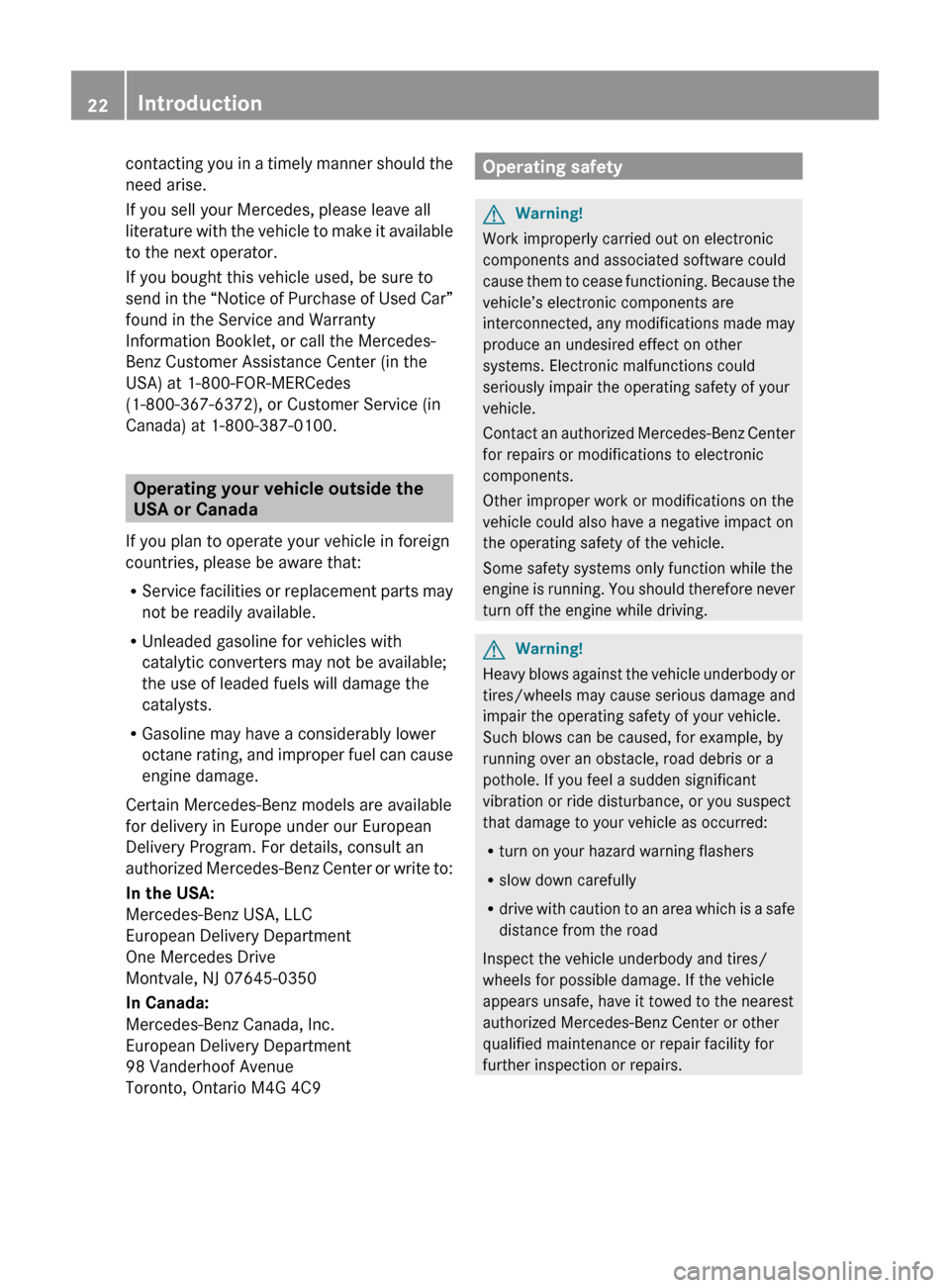
contacting you in a timely manner should the
need arise.
If you sell your Mercedes, please leave all
literature with the vehicle to make it available
to the next operator.
If you bought this vehicle used, be sure to
send in the “Notice of Purchase of Used Car”
found in the Service and Warranty
Information Booklet, or call the Mercedes-
Benz Customer Assistance Center (in the
USA) at 1-800-FOR-MERCedes
(1-800-367-6372), or Customer Service (in
Canada) at 1-800-387-0100.
Operating your vehicle outside the
USA or Canada
If you plan to operate your vehicle in foreign
countries, please be aware that:
R Service facilities or replacement parts may
not be readily available.
R Unleaded gasoline for vehicles with
catalytic converters may not be available;
the use of leaded fuels will damage the
catalysts.
R Gasoline may have a considerably lower
octane rating, and improper fuel can cause
engine damage.
Certain Mercedes-Benz models are available
for delivery in Europe under our European
Delivery Program. For details, consult an
authorized Mercedes-Benz Center or write to:
In the USA:
Mercedes-Benz USA, LLC
European Delivery Department
One Mercedes Drive
Montvale, NJ 07645-0350
In Canada:
Mercedes-Benz Canada, Inc.
European Delivery Department
98 Vanderhoof Avenue
Toronto, Ontario M4G 4C9
Operating safetyGWarning!
Work improperly carried out on electronic
components and associated software could
cause them to cease functioning. Because the
vehicle’s electronic components are
interconnected, any modifications made may
produce an undesired effect on other
systems. Electronic malfunctions could
seriously impair the operating safety of your
vehicle.
Contact an authorized Mercedes-Benz Center
for repairs or modifications to electronic
components.
Other improper work or modifications on the
vehicle could also have a negative impact on
the operating safety of the vehicle.
Some safety systems only function while the
engine is running. You should therefore never
turn off the engine while driving.
GWarning!
Heavy blows against the vehicle underbody or
tires/wheels may cause serious damage and
impair the operating safety of your vehicle.
Such blows can be caused, for example, by
running over an obstacle, road debris or a
pothole. If you feel a sudden significant
vibration or ride disturbance, or you suspect
that damage to your vehicle as occurred:
R turn on your hazard warning flashers
R slow down carefully
R drive with caution to an area which is a safe
distance from the road
Inspect the vehicle underbody and tires/
wheels for possible damage. If the vehicle
appears unsafe, have it towed to the nearest
authorized Mercedes-Benz Center or other
qualified maintenance or repair facility for
further inspection or repairs.
22Introduction204_AKB; 5; 23, en-USd2ureepe,Version: 2.11.8.12009-07-16T17:54:06+02:00 - Seite 22
Page 28 of 364
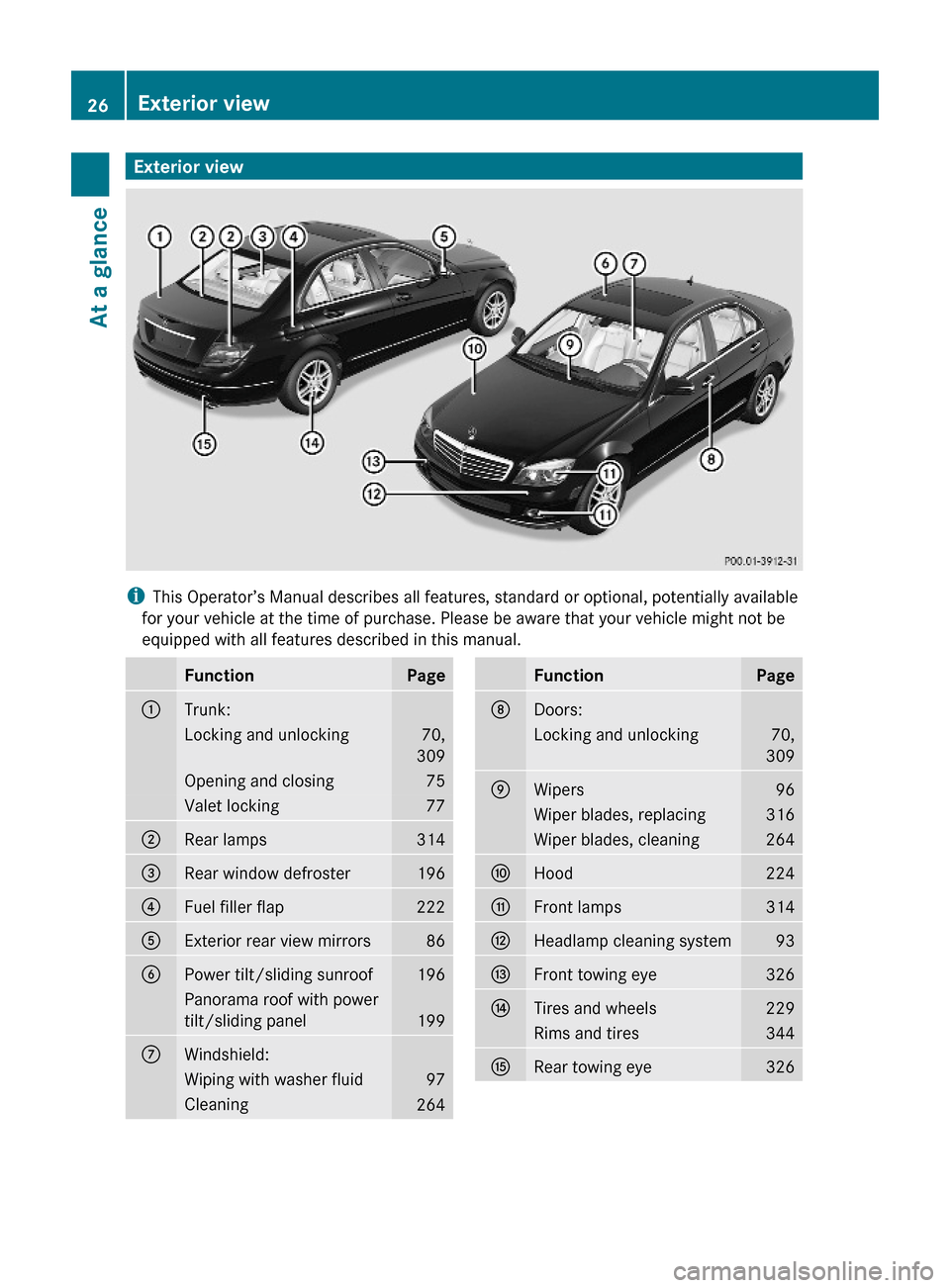
Exterior view
iThis Operator’s Manual describes all features, standard or optional, potentially available
for your vehicle at the time of purchase. Please be aware that your vehicle might not be
equipped with all features described in this manual.
FunctionPage:Trunk:Locking and unlocking70,
309
Opening and closing75Valet locking77;Rear lamps314=Rear window defroster196?Fuel filler flap222AExterior rear view mirrors86BPower tilt/sliding sunroof196Panorama roof with power
tilt/sliding panel199
CWindshield:Wiping with washer fluid97Cleaning264FunctionPageDDoors:Locking and unlocking70,
309
EWipers96Wiper blades, replacing316Wiper blades, cleaning264FHood224GFront lamps314HHeadlamp cleaning system93IFront towing eye326JTires and wheels229Rims and tires344KRear towing eye32626Exterior viewAt a glance
204_AKB; 5; 23, en-USd2ureepe,Version: 2.11.8.12009-07-16T17:54:06+02:00 - Seite 26
Page 54 of 364
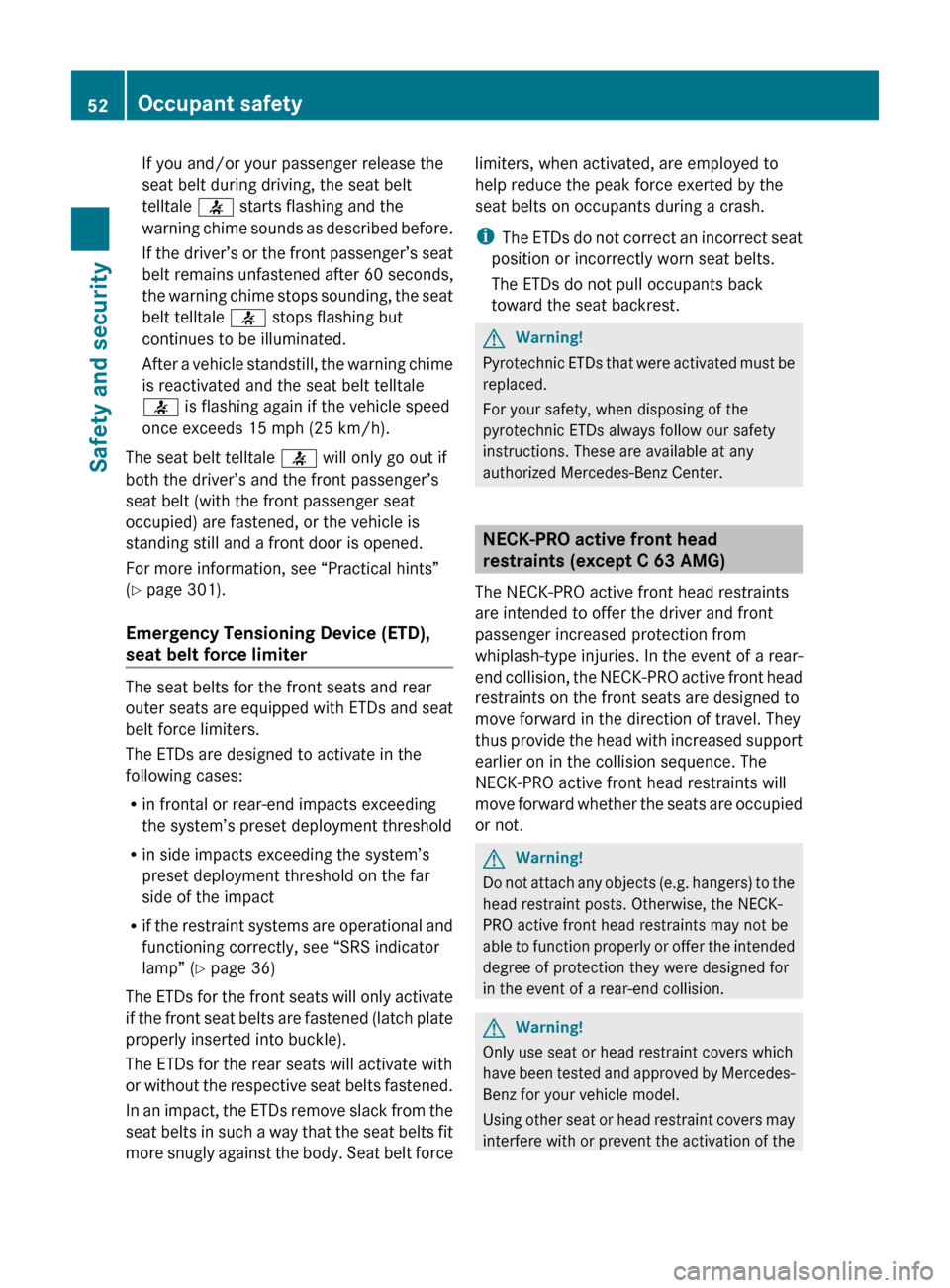
If you and/or your passenger release the
seat belt during driving, the seat belt
telltale 7 starts flashing and the
warning chime sounds as described before.
If the driver’s or the front passenger’s seat
belt remains unfastened after 60 seconds,
the warning chime stops sounding, the seat
belt telltale 7 stops flashing but
continues to be illuminated.
After a vehicle standstill, the warning chime
is reactivated and the seat belt telltale
7 is flashing again if the vehicle speed
once exceeds 15 mph (25 km/h).
The seat belt telltale 7 will only go out if
both the driver’s and the front passenger’s
seat belt (with the front passenger seat
occupied) are fastened, or the vehicle is
standing still and a front door is opened.
For more information, see “Practical hints”
( Y page 301).
Emergency Tensioning Device (ETD),
seat belt force limiter
The seat belts for the front seats and rear
outer seats are equipped with ETDs and seat
belt force limiters.
The ETDs are designed to activate in the
following cases:
R in frontal or rear-end impacts exceeding
the system’s preset deployment threshold
R in side impacts exceeding the system’s
preset deployment threshold on the far
side of the impact
R if the restraint systems are operational and
functioning correctly, see “SRS indicator
lamp” ( Y page 36)
The ETDs for the front seats will only activate
if the front seat belts are fastened (latch plate
properly inserted into buckle).
The ETDs for the rear seats will activate with
or without the respective seat belts fastened.
In an impact, the ETDs remove slack from the
seat belts in such a way that the seat belts fit
more snugly against the body. Seat belt force
limiters, when activated, are employed to
help reduce the peak force exerted by the
seat belts on occupants during a crash.
i The ETDs do not correct an incorrect seat
position or incorrectly worn seat belts.
The ETDs do not pull occupants back
toward the seat backrest.GWarning!
Pyrotechnic ETDs that were activated must be
replaced.
For your safety, when disposing of the
pyrotechnic ETDs always follow our safety
instructions. These are available at any
authorized Mercedes-Benz Center.
NECK-PRO active front head
restraints (except C 63 AMG)
The NECK-PRO active front head restraints
are intended to offer the driver and front
passenger increased protection from
whiplash-type injuries. In the event of a rear-
end collision, the NECK-PRO active front head
restraints on the front seats are designed to
move forward in the direction of travel. They
thus provide the head with increased support
earlier on in the collision sequence. The
NECK-PRO active front head restraints will
move forward whether the seats are occupied
or not.
GWarning!
Do not attach any objects (e.g. hangers) to the
head restraint posts. Otherwise, the NECK-
PRO active front head restraints may not be
able to function properly or offer the intended
degree of protection they were designed for
in the event of a rear-end collision.
GWarning!
Only use seat or head restraint covers which
have been tested and approved by Mercedes-
Benz for your vehicle model.
Using other seat or head restraint covers may
interfere with or prevent the activation of the
52Occupant safetySafety and security
204_AKB; 5; 23, en-USd2ureepe,Version: 2.11.8.12009-07-16T17:54:06+02:00 - Seite 52
Page 65 of 364
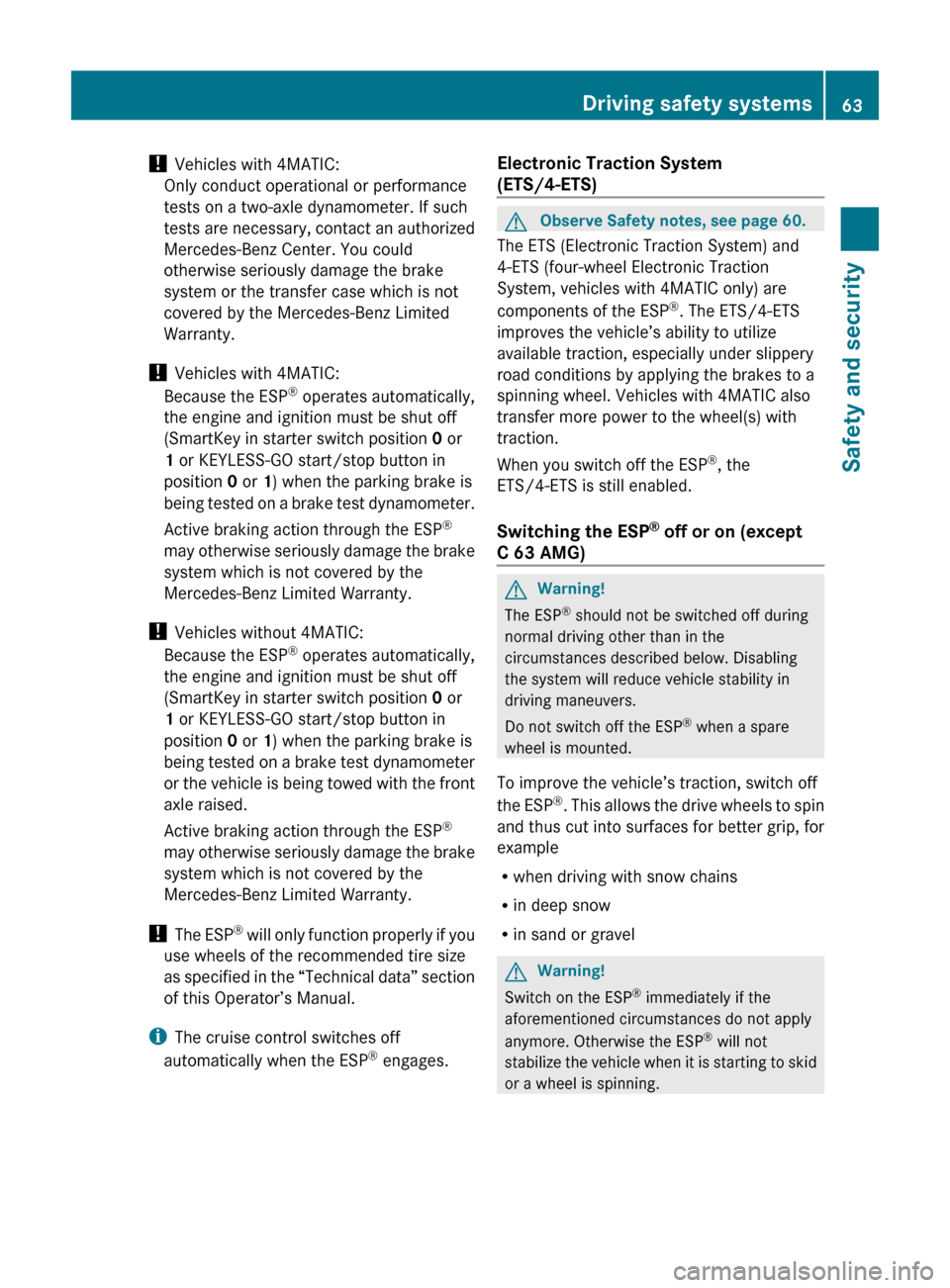
! Vehicles with 4MATIC:
Only conduct operational or performance
tests on a two-axle dynamometer. If such
tests are necessary, contact an authorized
Mercedes-Benz Center. You could
otherwise seriously damage the brake
system or the transfer case which is not
covered by the Mercedes-Benz Limited
Warranty.
! Vehicles with 4MATIC:
Because the ESP ®
operates automatically,
the engine and ignition must be shut off
(SmartKey in starter switch position 0 or
1 or KEYLESS-GO start/stop button in
position 0 or 1) when the parking brake is
being tested on a brake test dynamometer.
Active braking action through the ESP ®
may otherwise seriously damage the brake
system which is not covered by the
Mercedes-Benz Limited Warranty.
! Vehicles without 4MATIC:
Because the ESP ®
operates automatically,
the engine and ignition must be shut off
(SmartKey in starter switch position 0 or
1 or KEYLESS-GO start/stop button in
position 0 or 1) when the parking brake is
being tested on a brake test dynamometer
or the vehicle is being towed with the front
axle raised.
Active braking action through the ESP ®
may otherwise seriously damage the brake
system which is not covered by the
Mercedes-Benz Limited Warranty.
! The ESP ®
will only function properly if you
use wheels of the recommended tire size
as specified in the “Technical data” section
of this Operator’s Manual.
i The cruise control switches off
automatically when the ESP ®
engages.Electronic Traction System
(ETS/4-ETS) GObserve Safety notes, see page 60.
The ETS (Electronic Traction System) and
4-ETS (four-wheel Electronic Traction
System, vehicles with 4MATIC only) are
components of the ESP ®
. The ETS/4-ETS
improves the vehicle’s ability to utilize
available traction, especially under slippery
road conditions by applying the brakes to a
spinning wheel. Vehicles with 4MATIC also
transfer more power to the wheel(s) with
traction.
When you switch off the ESP ®
, the
ETS/4-ETS is still enabled.
Switching the ESP ®
off or on (except
C 63 AMG)
GWarning!
The ESP ®
should not be switched off during
normal driving other than in the
circumstances described below. Disabling
the system will reduce vehicle stability in
driving maneuvers.
Do not switch off the ESP ®
when a spare
wheel is mounted.
To improve the vehicle’s traction, switch off
the ESP ®
. This allows the drive wheels to spin
and thus cut into surfaces for better grip, for
example
R when driving with snow chains
R in deep snow
R in sand or gravel
GWarning!
Switch on the ESP ®
immediately if the
aforementioned circumstances do not apply
anymore. Otherwise the ESP ®
will not
stabilize the vehicle when it is starting to skid
or a wheel is spinning.
Driving safety systems63Safety and security204_AKB; 5; 23, en-USd2ureepe,Version: 2.11.8.12009-07-16T17:54:06+02:00 - Seite 63Z
Page 77 of 364
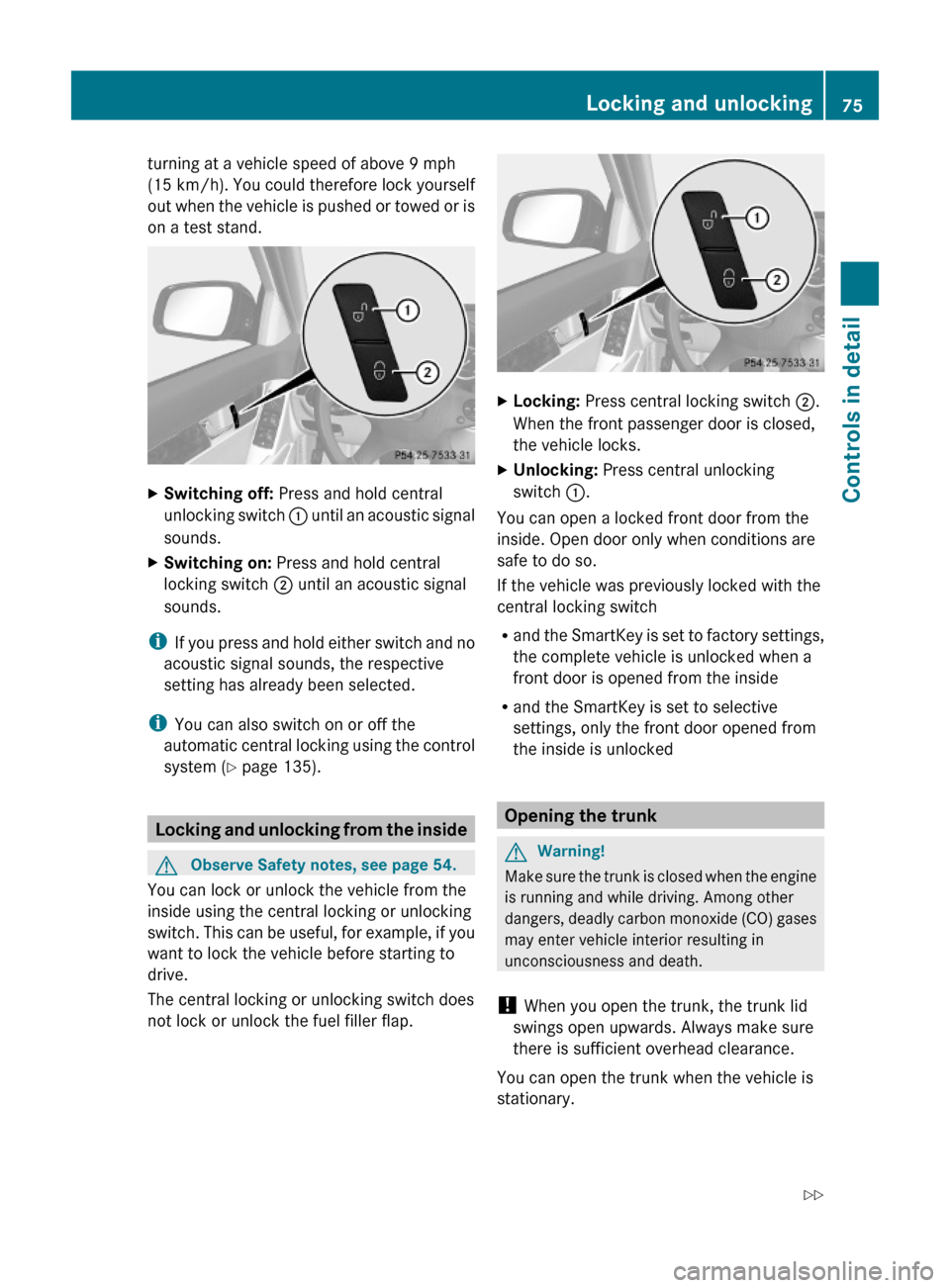
turning at a vehicle speed of above 9 mph
(15 km/h). You could therefore lock yourself
out when the vehicle is pushed or towed or is
on a test stand.
XSwitching off: Press and hold central
unlocking switch : until an acoustic signal
sounds.
XSwitching on: Press and hold central
locking switch ; until an acoustic signal
sounds.
iIf you press and hold either switch and no
acoustic signal sounds, the respective
setting has already been selected.
iYou can also switch on or off the
automatic central locking using the control
system (Y page 135).
Locking and unlocking from the inside
GObserve Safety notes, see page 54.
You can lock or unlock the vehicle from the
inside using the central locking or unlocking
switch. This can be useful, for example, if you
want to lock the vehicle before starting to
drive.
The central locking or unlocking switch does
not lock or unlock the fuel filler flap.
XLocking: Press central locking switch ;.
When the front passenger door is closed,
the vehicle locks.
XUnlocking: Press central unlocking
switch :.
You can open a locked front door from the
inside. Open door only when conditions are
safe to do so.
If the vehicle was previously locked with the
central locking switch
Rand the SmartKey is set to factory settings,
the complete vehicle is unlocked when a
front door is opened from the inside
Rand the SmartKey is set to selective
settings, only the front door opened from
the inside is unlocked
Opening the trunk
GWarning!
Make sure the trunk is closed when the engine
is running and while driving. Among other
dangers, deadly carbon monoxide (CO) gases
may enter vehicle interior resulting in
unconsciousness and death.
! When you open the trunk, the trunk lid
swings open upwards. Always make sure
there is sufficient overhead clearance.
You can open the trunk when the vehicle is
stationary.
Locking and unlocking75Controls in detail204_AKB; 5; 23, en-USd2ureepe,Version: 2.11.8.12009-07-16T17:54:06+02:00 - Seite 75Z
Page 88 of 364
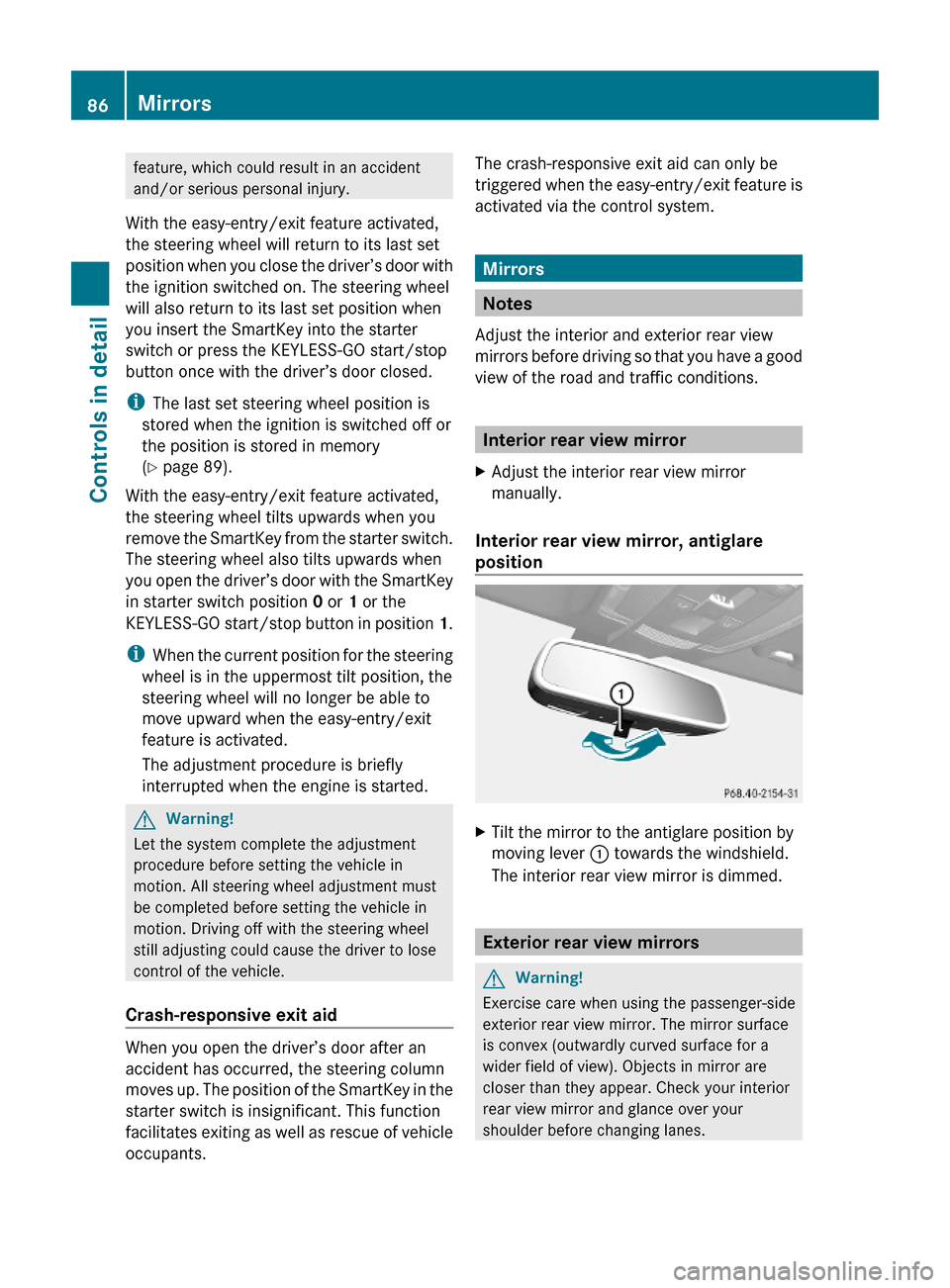
feature, which could result in an accident
and/or serious personal injury.
With the easy-entry/exit feature activated,
the steering wheel will return to its last set
position when you close the driver’s door with
the ignition switched on. The steering wheel
will also return to its last set position when
you insert the SmartKey into the starter
switch or press the KEYLESS-GO start/stop
button once with the driver’s door closed.
iThe last set steering wheel position is
stored when the ignition is switched off or
the position is stored in memory
(Y page 89).
With the easy-entry/exit feature activated,
the steering wheel tilts upwards when you
remove the SmartKey from the starter switch.
The steering wheel also tilts upwards when
you open the driver’s door with the SmartKey
in starter switch position 0 or 1 or the
KEYLESS-GO start/stop button in position 1.
iWhen the current position for the steering
wheel is in the uppermost tilt position, the
steering wheel will no longer be able to
move upward when the easy-entry/exit
feature is activated.
The adjustment procedure is briefly
interrupted when the engine is started.
GWarning!
Let the system complete the adjustment
procedure before setting the vehicle in
motion. All steering wheel adjustment must
be completed before setting the vehicle in
motion. Driving off with the steering wheel
still adjusting could cause the driver to lose
control of the vehicle.
Crash-responsive exit aid
When you open the driver’s door after an
accident has occurred, the steering column
moves up. The position of the SmartKey in the
starter switch is insignificant. This function
facilitates exiting as well as rescue of vehicle
occupants.
The crash-responsive exit aid can only be
triggered when the easy-entry/exit feature is
activated via the control system.
Mirrors
Notes
Adjust the interior and exterior rear view
mirrors before driving so that you have a good
view of the road and traffic conditions.
Interior rear view mirror
XAdjust the interior rear view mirror
manually.
Interior rear view mirror, antiglare
position
XTilt the mirror to the antiglare position by
moving lever : towards the windshield.
The interior rear view mirror is dimmed.
Exterior rear view mirrors
GWarning!
Exercise care when using the passenger-side
exterior rear view mirror. The mirror surface
is convex (outwardly curved surface for a
wider field of view). Objects in mirror are
closer than they appear. Check your interior
rear view mirror and glance over your
shoulder before changing lanes.
86MirrorsControls in detail
204_AKB; 5; 23, en-USd2ureepe,Version: 2.11.8.12009-07-16T17:54:06+02:00 - Seite 86
Page 107 of 364
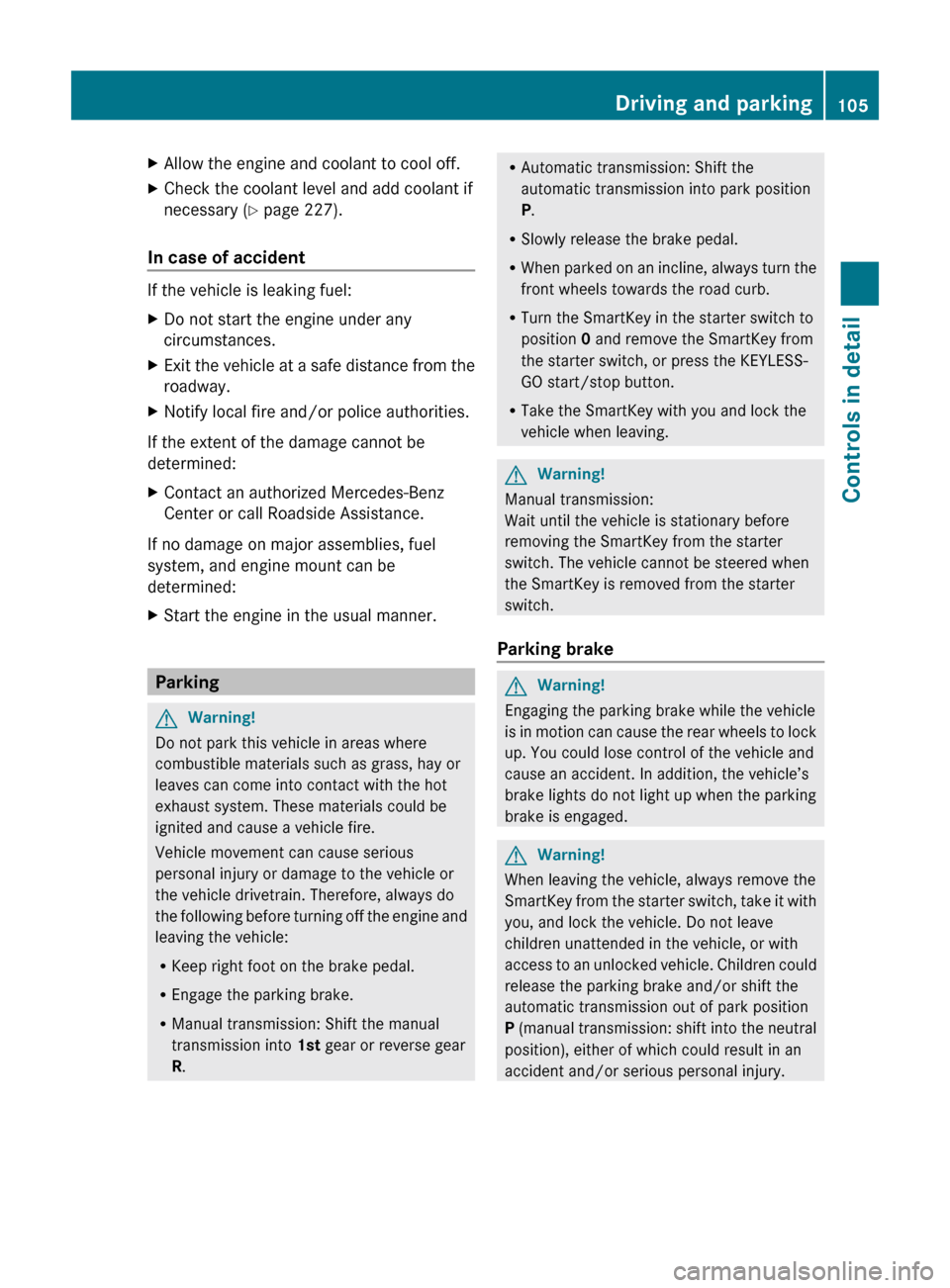
XAllow the engine and coolant to cool off.XCheck the coolant level and add coolant if
necessary ( Y page 227).
In case of accident
If the vehicle is leaking fuel:
XDo not start the engine under any
circumstances.XExit the vehicle at a safe distance from the
roadway.XNotify local fire and/or police authorities.
If the extent of the damage cannot be
determined:
XContact an authorized Mercedes-Benz
Center or call Roadside Assistance.
If no damage on major assemblies, fuel
system, and engine mount can be
determined:
XStart the engine in the usual manner.
Parking
GWarning!
Do not park this vehicle in areas where
combustible materials such as grass, hay or
leaves can come into contact with the hot
exhaust system. These materials could be
ignited and cause a vehicle fire.
Vehicle movement can cause serious
personal injury or damage to the vehicle or
the vehicle drivetrain. Therefore, always do
the following before turning off the engine and
leaving the vehicle:
R Keep right foot on the brake pedal.
R Engage the parking brake.
R Manual transmission: Shift the manual
transmission into 1st gear or reverse gear
R .
R
Automatic transmission: Shift the
automatic transmission into park position
P .
R Slowly release the brake pedal.
R When parked on an incline, always turn the
front wheels towards the road curb.
R Turn the SmartKey in the starter switch to
position 0 and remove the SmartKey from
the starter switch, or press the KEYLESS-
GO start/stop button.
R Take the SmartKey with you and lock the
vehicle when leaving.GWarning!
Manual transmission:
Wait until the vehicle is stationary before
removing the SmartKey from the starter
switch. The vehicle cannot be steered when
the SmartKey is removed from the starter
switch.
Parking brake
GWarning!
Engaging the parking brake while the vehicle
is in motion can cause the rear wheels to lock
up. You could lose control of the vehicle and
cause an accident. In addition, the vehicle’s
brake lights do not light up when the parking
brake is engaged.
GWarning!
When leaving the vehicle, always remove the
SmartKey from the starter switch, take it with
you, and lock the vehicle. Do not leave
children unattended in the vehicle, or with
access to an unlocked vehicle. Children could
release the parking brake and/or shift the
automatic transmission out of park position
P (manual transmission: shift into the neutral
position), either of which could result in an
accident and/or serious personal injury.
Driving and parking105Controls in detail204_AKB; 5; 23, en-USd2ureepe,Version: 2.11.8.12009-07-16T17:54:06+02:00 - Seite 105Z